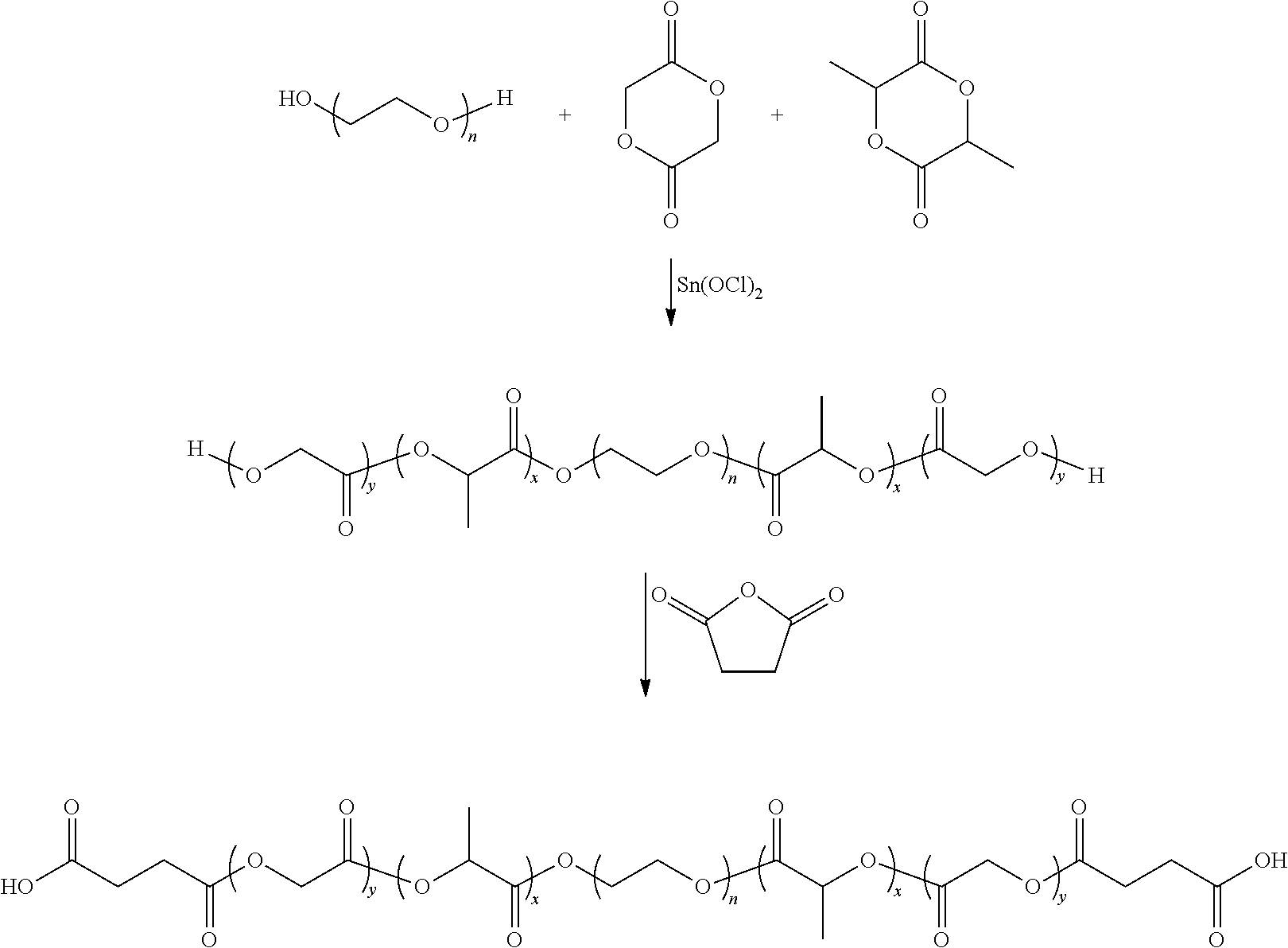Microparticles and nanoparticles having negative surface charges
a technology of surface charges and microparticles, which is applied in the direction of nanocapsules, pharmaceutical delivery mechanisms, capsule delivery, etc., can solve the problems that the number of carboxyl groups of plga particles produced using conventional means is not sufficient for attaching api, and the safety of use of plga particles resulting from such manufacturing processes is not guaranteed. , to achieve the effect of increasing the number of carboxyl groups
- Summary
- Abstract
- Description
- Claims
- Application Information
AI Technical Summary
Benefits of technology
Problems solved by technology
Method used
Image
Examples
example 1
[0197]Preparation of Carboxylated PLGA Nanoparticles via Emulsification Process with Hyaluronic Acid
[0198]0.75 g PLGA (Lakeshore DLG 5050 4.5A) was dissolved in 15 ml methylene chloride. The PLGA solution was mixed with 150 ml 1% polyvinyl alcohol solution containing 0.2 gram of hyaluronic acid, and homogenized at 12,500 rpm for 90 seconds on a NISSEN Homogenizer. The resulting emulsion was poured to a glass container and stirred magnetically at 400 rpm for 4 hours to allow the evaporation of the solvent. The nanoparticles were washed three times with distilled water before they were lyophilized.
[0199]Particle size and zeta potential were determined with a Malvern particle size analyzer (Worcestershire, UK). The average particle size was found to be 122.5 nm and zeta potential was −31.2 mV.
example 2
Preparation of Carboxylated PLGA Nanoparticles via Emulsification Process with a Short-Chain PLGA Polymer
[0200]0.19 g PLGA (Lactel B6013, inherent viscosity 0.15-0.25 dL / g) was dissolved in 10 ml methylene chloride. The PLGA solution was mixed with 100 ml 1% polyvinyl alcohol solution and homogenized at 18,400 rpm for 45 seconds with an IKA T25_digital_ULTRA-TURRAX Homogenizer. The resulting emulsion was poured to a glass container and stirred magnetically at 400 rpm for 4 hours to allow the evaporation of the solvent. The nanoparticles were washed three times with distilled water before they were lyophilized.
[0201]Particle size and zeta potential were determined with a Beckman-Coulter LS320
[0202]Laser Diffraction Particle Size Analyzer. The average particle size was found to be 680 nm.
example 3
Preparation of Carboxylated PLGA Nanoparticles via Precipitation Process with a Short-Chain PLGA Polymer
[0203]0.42 g PLGA polymer (Lakeshore DLG 5050 1A, inherent viscosity 0.05-0.15 dL / g) was dissolved in 10 ml acetone. This PLGA / acetone solution was added using a syringe pump at an addition rate of about 25 mL / hour to 60 mL 1 mM NaOH solution. The resulting nanoparticle suspension was mixed with 1 liter of distilled water and concentrated to approximately 20 mL with a tangential flow filtration device and a 500 kDa molecular weight cut-off module. The concentrated nanoparticle suspension was lyophilized.
[0204]Particle size and zeta potential were determined with a Malvern particle size analyzer (Worcestershire, UK). The average particle size was found to be 230.4 nm and zeta potential was −31.1 mV.
PUM
| Property | Measurement | Unit |
|---|---|---|
| molecular weight | aaaaa | aaaaa |
| molecular weight | aaaaa | aaaaa |
| particle sizes | aaaaa | aaaaa |
Abstract
Description
Claims
Application Information
 Login to View More
Login to View More - R&D
- Intellectual Property
- Life Sciences
- Materials
- Tech Scout
- Unparalleled Data Quality
- Higher Quality Content
- 60% Fewer Hallucinations
Browse by: Latest US Patents, China's latest patents, Technical Efficacy Thesaurus, Application Domain, Technology Topic, Popular Technical Reports.
© 2025 PatSnap. All rights reserved.Legal|Privacy policy|Modern Slavery Act Transparency Statement|Sitemap|About US| Contact US: help@patsnap.com

